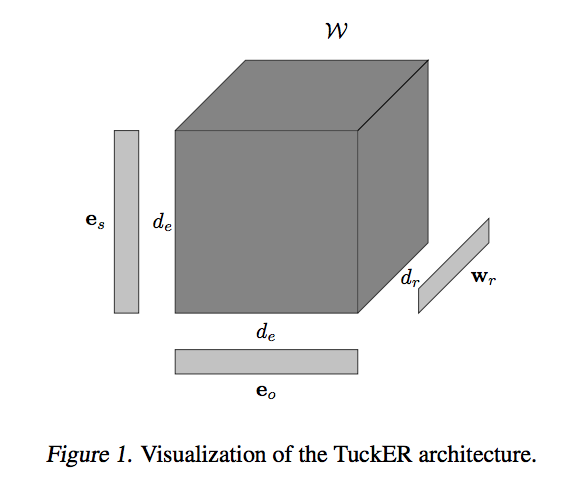This codebase contains PyTorch implementation of the paper:
TuckER: Tensor Factorization for Knowledge Graph Completion. Ivana Balažević, Carl Allen, and Timothy M. Hospedales. Empirical Methods in Natural Language Processing (EMNLP), 2019. [Paper]
TuckER: Tensor Factorization for Knowledge Graph Completion. Ivana Balažević, Carl Allen, and Timothy M. Hospedales. ICML Adaptive & Multitask Learning Workshop, 2019. [Short Paper]
| Dataset | MRR | Hits@10 | Hits@3 | Hits@1 |
|---|---|---|---|---|
| FB15k | 0.795 | 0.892 | 0.833 | 0.741 |
| WN18 | 0.953 | 0.958 | 0.955 | 0.949 |
| FB15k-237 | 0.358 | 0.544 | 0.394 | 0.266 |
| WN18RR | 0.470 | 0.526 | 0.482 | 0.443 |
To run the model, execute the following command:
CUDA_VISIBLE_DEVICES=0 python main.py --dataset FB15k-237 --num_iterations 500 --batch_size 128
--lr 0.0005 --dr 1.0 --edim 200 --rdim 200 --input_dropout 0.3
--hidden_dropout1 0.4 --hidden_dropout2 0.5 --label_smoothing 0.1
Available datasets are:
FB15k-237
WN18RR
FB15k
WN18
To reproduce the results from the paper, use the following combinations of hyperparameters with batch_size=128:
| dataset | lr | dr | edim | rdim | input_d | hidden_d1 | hidden_d2 | label_smoothing |
|---|---|---|---|---|---|---|---|---|
| FB15k | 0.003 | 0.99 | 200 | 200 | 0.2 | 0.2 | 0.3 | 0. |
| WN18 | 0.005 | 0.995 | 200 | 30 | 0.2 | 0.1 | 0.2 | 0.1 |
| FB15k-237 | 0.0005 | 1.0 | 200 | 200 | 0.3 | 0.4 | 0.5 | 0.1 |
| WN18RR | 0.003 | 1.0 | 200 | 30 | 0.2 | 0.2 | 0.3 | 0.1 |
The codebase is implemented in Python 3.6.6. Required packages are:
numpy 1.15.1
pytorch 1.0.1
If you found this codebase useful, please cite:
@inproceedings{balazevic2019tucker,
title={TuckER: Tensor Factorization for Knowledge Graph Completion},
author={Bala\v{z}evi\'c, Ivana and Allen, Carl and Hospedales, Timothy M},
booktitle={Empirical Methods in Natural Language Processing},
year={2019}
}


